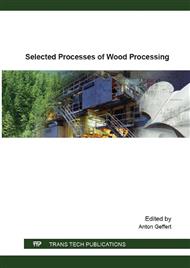p.82
p.90
p.96
p.104
p.115
p.122
p.131
p.138
p.145
The Effect of Thickness of Medium Density Fiberboard Produced of Hardwood Tree Species on their Selected Physical and Mechanical Properties
Abstract:
In Bulgaria, there is sufficient raw material as well as established technologies for fiberboard production of hardwood tree species. In general, MDF production from such raw-material is characterized by a number of technological difficulties mainly related to low compression ratio and smaller slenderness of fiber elements. The presented scientific experiments cover characteristic features and the effect of different thicknesses on the production of MDF from hardwood tree species – beech (Fagus silvatica L) and Turkey oak (Quercus cerris L). The experimental matrix and regime factors of hot-pressing are in correlation with thicknesses of boards. The regression models describing the effect of thicknesses on main properties of medium-density fiberboard are deduced and analyzed from the output data and the proper conclusions are made.
Info:
Periodical:
Pages:
115-121
Citation:
Online since:
April 2016
Authors:
Price:
Сopyright:
© 2016 Trans Tech Publications Ltd. All Rights Reserved
Share:
Citation:


